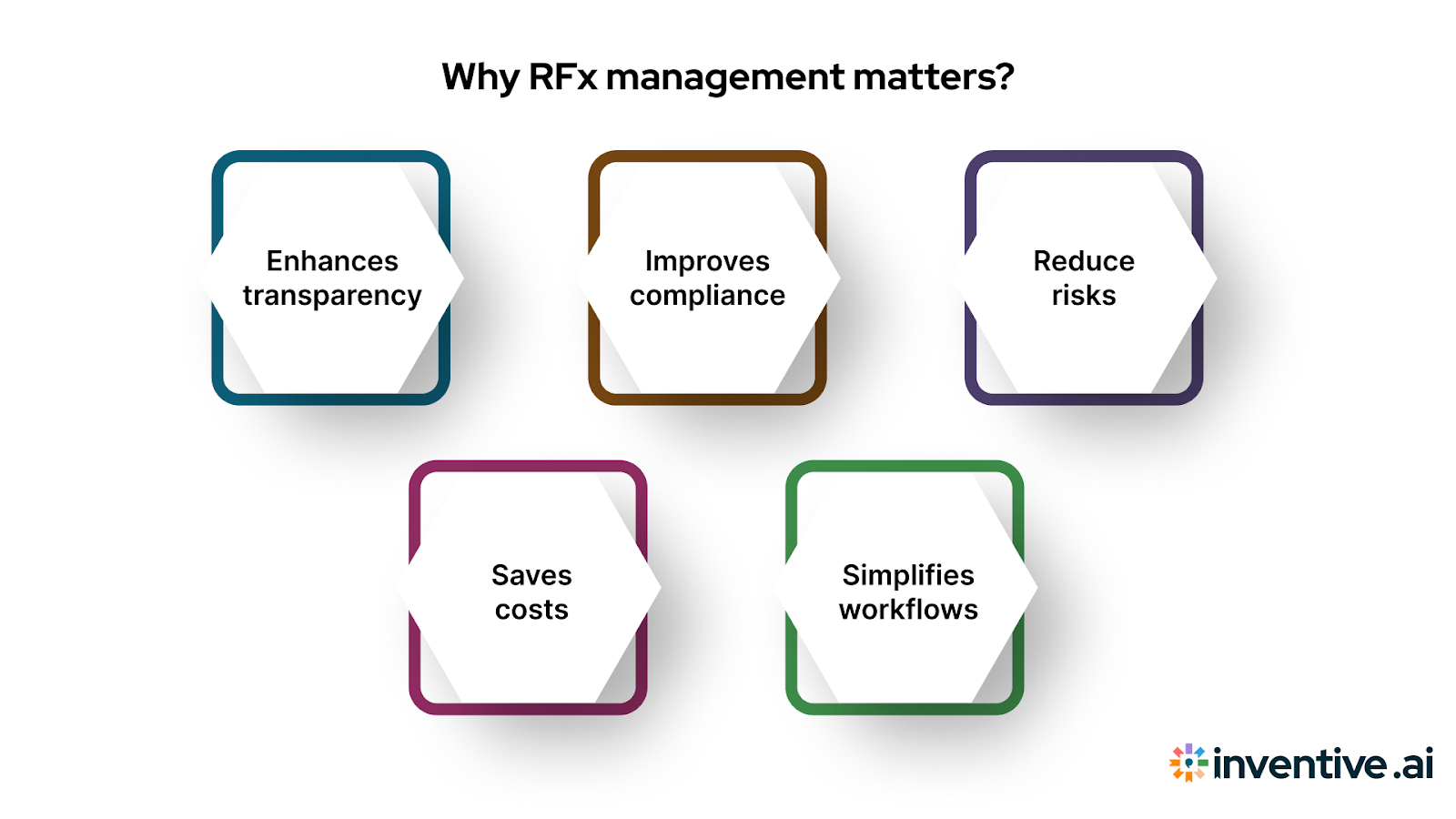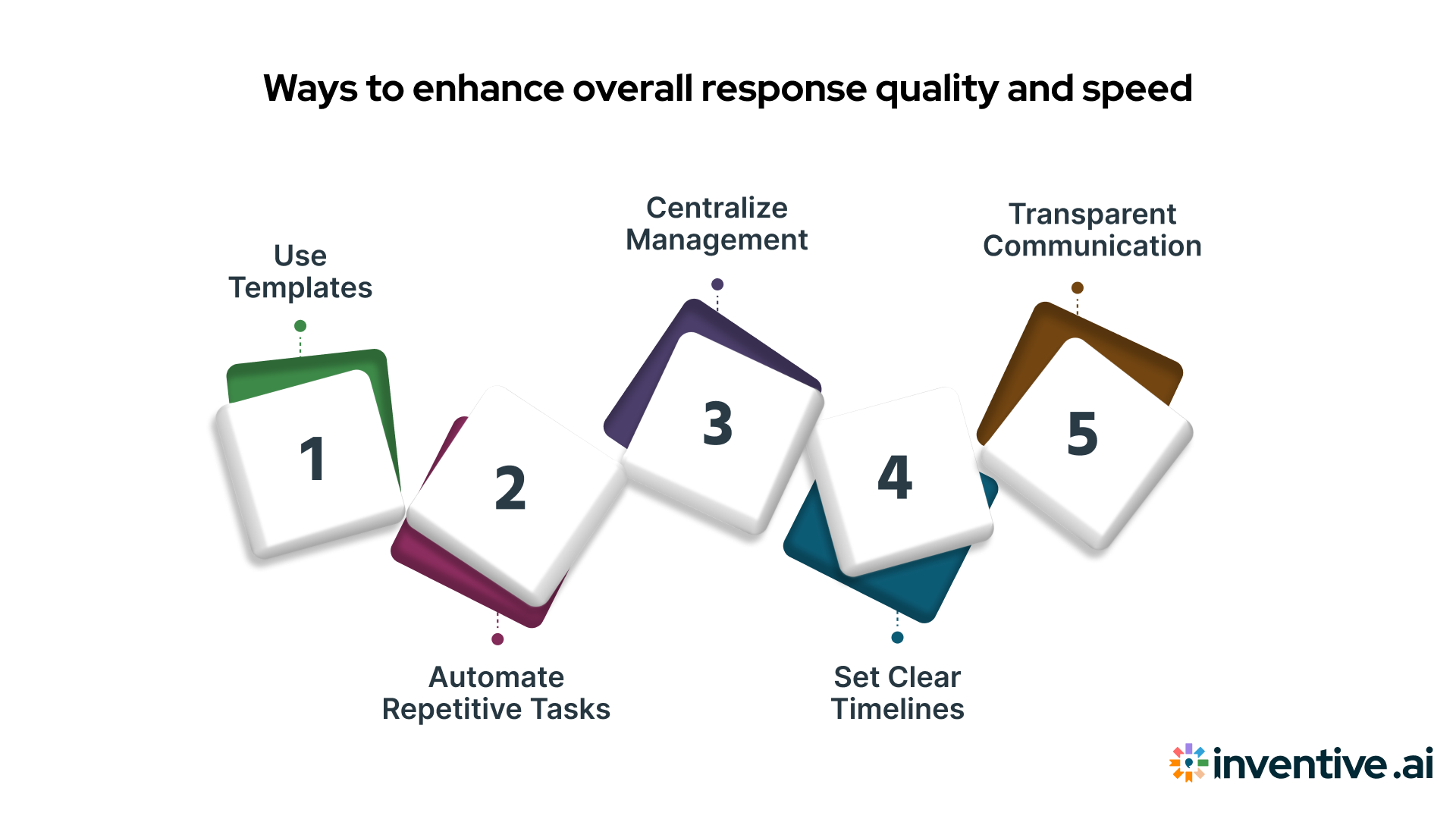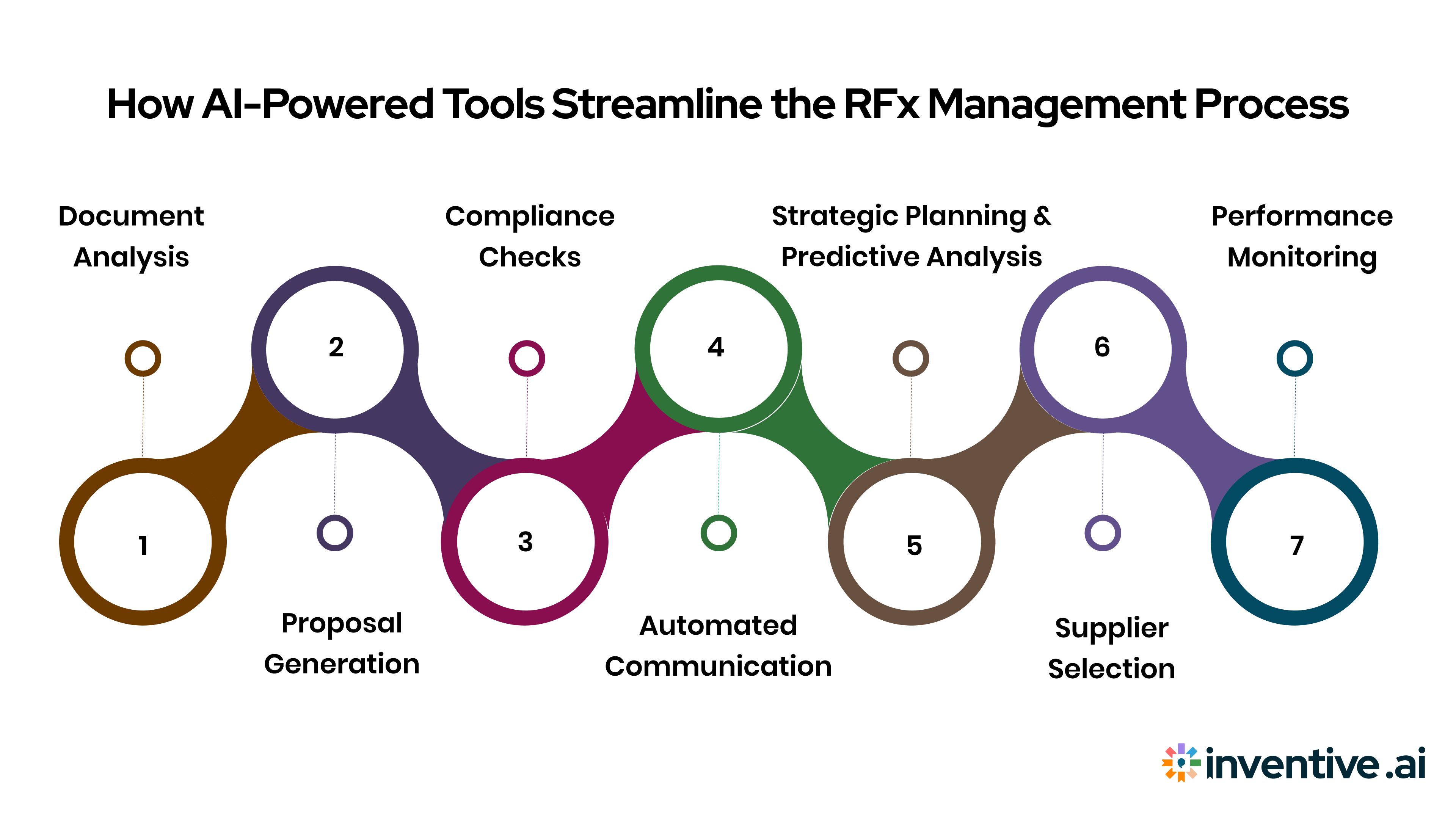What is RFx Management? A Guide to the Process and AI Tools
In this guide, you will learn about how RFx management works, its types, essential processes, challenges vendors face, and how AI can improve your bidding strategy.

Are you struggling to keep up with the growing volume and complexity of procurement requests?
Nearly 60% of small and mid-sized businesses have lost 15% or more in revenue due to supply chain delays. Moreover, 56% of organizations switched suppliers in one year because of performance issues.
These challenges affect how vendors align with complex RFx management, often causing missed opportunities and increased costs. Vendors need clear processes and tools to meet stricter buyer demands and shorten response cycles.
In this guide, you will learn about how RFx management works, its types, essential processes, challenges vendors face, and how AI can improve your bidding strategy.
Key Takeaways
- RFx covers processes like RFI, RFP, and RFQ, each designed for different procurement needs and stages. Vendors gain a clear structure for responding to buyer requirements and presenting key information.
- Standardized RFx management improves accuracy, transparency, and response quality. Vendors benefit from consistent formats and objective evaluation, helping stand out in competitive bidding situations.
- Digital tools simplify RFx workflows by centralizing documents, tracking submissions, and spotlighting important deadlines. Automation reduces manual errors and frees up valuable time for vendors.
- Thorough RFx processes help assess supplier risk, compliance, and historical performance, supporting better decision-making and reducing the chance of costly mistakes.
- Collaboration and clear communication across internal teams and with buyers are essential for producing complete, high-quality responses, leading to better contract outcomes and long-term success.
What Is RFx Management?
RFx management refers to handling procurement requests that vendors receive and respond to during sourcing. The term “RFx” represents various formal requests, such as Request for Information (RFI), Request for Proposal (RFP), and Request for Quotation (RFQ). Each request type serves a distinct purpose.
This process involves issuing clear, standardized requests to vendors and managing their responses efficiently to ensure consistent communication and fair evaluation of all potential vendors.
For vendors, understanding RFx management means grasping how to interpret, organize, and deliver precise responses that meet buyer expectations. Now, let’s discuss the importance of RFx management in detail.
Why is RFx Important in Procurement?

The importance of RFx management lies in its ability to bring order, fairness, and strategic focus to the complex vendor selection process. Without a structured RFx approach, procurement often risks inefficiencies, biased decisions, and non-compliance issues that can lead to poor supplier choices or missed opportunities.
Here are a few reasons why RFx management matters:
- Enhances transparency: All vendors receive the same information and are evaluated on equal grounds, promoting supplier trust and accountability.
- Improves compliance: Standardized evaluations and audit trails ensure procurement meets internal policies and external regulatory requirements.
- Reduces risks: Comprehensive RFx processes help identify and disqualify unreliable or risky vendors before contracting.
- Saves costs: Competitive bidding encouraged through RFx typically results in better pricing and value-added proposals.
- Simplifies workflows: Clear steps and automation reduce manual errors and rework, accelerating cycle times and freeing up procurement staff for strategic tasks.
These strengths make RFx management an essential part of procurement success. RFx management is not just a procedural necessity but a strategic assistant for procurement quality and business value. Now, let’s discuss the various types of RFx used in sourcing.
Types of RFx: RFI, RFQ, RFP, and More
Understanding the types of RFx requests helps vendors prepare precise and targeted responses. Each RFx type corresponds to a specific procurement need, whether gathering general information, getting detailed proposals, or requesting price quotes.
This clarity allows sellers to personalize their bids accurately and efficiently to meet buyers' expectations. Here are the types of RFx used in the procurement process:
- Request for Information (RFI): An exploratory document sent early in the sourcing process primarily to gather broad market data or vendor capabilities. RFIs are useful when the buyer seeks to scope options, technologies, or industry practices before formulating detailed requirements.
- Request for Quotation (RFQ): Used when the buyer has clear specifications and needs price quotes to compare costs. RFQs focus mostly on pricing and delivery terms rather than solution approaches.
- Request for Proposal (RFP): A comprehensive request requesting detailed proposals that include technical solutions, methodology, timelines, and pricing. RFPs are issued when buyers seek innovative, value-based responses addressing complex needs.
- Request for Tender (RFT): Similar to an RFP but often used in public sector procurements where transparency and formal bid submissions are required. For example, a city government issuing an RFT to build new infrastructure, such as a bridge or public housing, will invite suppliers to submit sealed bids detailing costs, timelines, and technical qualifications. These bids are then evaluated to select the most suitable contractor in a fair and open process.
- Request for Application (RFA): It invites qualified vendors to apply when specific certifications or capabilities are crucial.
For instance, a healthcare agency may issue an RFA to find medical equipment suppliers who meet rigid regulatory standards. Only vendors with the required credentials can apply, ensuring compliance and quality before the selection phase.
Knowing which RFx document to use based on procurement stage and objectives optimizes vendor engagement and decision making. To further clarify how these key RFx types differ and guide vendors in customizing their responses effectively, consider this quick comparison of RFI, RFQ, and RFP.
RFI vs. RFQ vs. RFP: A Quick Comparison for Vendors
Understanding the differences between RFI, RFQ, and RFP is essential for vendors aiming to personalize responses that meet specific buyer expectations. Each RFx type serves a distinct purpose within the procurement lifecycle, guiding how vendors approach information gathering, pricing, and solution proposals.
Here is a quick comparison highlighting the key criteria to help vendors align their responses effectively and boost their chances of success:
This table helps vendors quickly understand how to structure responses and maximize their chances with each RFx type, ensuring targeted efforts throughout the procurement cycle. With this comparison in your toolkit, understanding the core processes of RFx management will help you respond effectively and increase your chances of winning.
Core Processes in RFx Management
RFx management is a structured process that vendors must utilize to submit competitive, tailored proposals. Understanding each step can help save time, increase accuracy, and improve success. Here are the core RFx processes you should focus on to streamline your approach:

- Initiation & Planning
The buyer identifies business needs and aligns stakeholders, then makes a Go/No-Go decision. Vendors must also assess if the opportunity aligns with their goals and capabilities. This step ensures resources aren’t wasted on unsuitable projects. - RFx Creation
The buyer drafts the RFx documents, outlining requirements and evaluation criteria. Vendors should carefully review these to understand the buyer’s expectations and tailor their response accordingly. - Vendor Identification & Distribution
After finalizing the RFx, the buyer shortlists vendors. Vendors must ensure they’re on the distribution list and that the RFx matches their expertise. Confirming receipt is crucial to avoid missing the opportunity. - Response Management
Vendors collect necessary information and prepare proposals, addressing all RFx requirements. A centralized system helps track responses, ensuring timely and complete submissions. - Evaluation & Scoring
The buyer evaluates responses based on criteria like cost and technical compliance. Vendors should align their proposals with these factors to improve scoring and demonstrate how their solution meets the buyer’s needs. - Vendor Selection & Negotiation
After evaluation, the buyer shortlists vendors for further clarifications or negotiations. Vendors should be prepared to provide additional details or adjustments and showcase flexibility to strengthen their position. - Post-Award Management
Once awarded, vendors must focus on fulfilling contract terms. Monitoring performance ensures strong relationships and helps improve future RFx responses.
Learn how to create an effective RFP checklist with our comprehensive RFP checklist for winning proposals.
Understanding these core processes allows vendors to learn RFx cycles better and position their proposals to win. However, it is important to consider the key components that make RFx management efficient and fair.
Key Components for Effective RFx Management
Effective RFx management relies on several key components that vendors should understand to improve their response quality and success.
These components help structure communications, ensure fairness, and maintain clarity throughout the procurement cycle. Knowing them allows vendors to meet buyer expectations and simplify their own processes.
The essential components of RFx responses include the following:
- Clear Documentation: Detailed, standardized RFx documents clearly state requirements, expectations, and evaluation methods. For vendors, this clarity ensures that responses address all buyer needs accurately, eliminating confusion and reducing the chance of disqualification due to incomplete or irrelevant information.
- Stakeholder Collaboration: Effective RFx management involves input from multiple buyer departments such as finance, legal, and technical teams. Vendors should anticipate cross-functional requirements and customize proposals to meet diverse stakeholder priorities, increasing alignment and response relevance.
- Defined Evaluation Criteria: Buyers use scorecards or matrices based on cost, quality, compliance, and other factors to objectively assess vendors. Vendors who understand and respond directly to these criteria improve their chances of scoring higher and advancing in the process.
- Centralized Tracking Systems: Procurement teams often use platforms to manage RFx documents, timelines, and vendor submissions in one place. Vendors benefit from these systems through timely notifications, simplified submissions, and clear status updates, helping avoid missed deadlines or lost communications.
- Transparent Communication: Open, documented exchanges between buyers and vendors about questions, clarifications, and feedback maintain fairness and trust. Vendors should actively engage via official channels, providing prompt and precise responses to ensure continued eligibility and credibility.
Understanding these components aligns vendors to learn complex RFx demands confidently and efficiently. Simplifying RFx management is the next step in reducing errors and accelerating response cycles.
How to Standardize and Simplify RFx Management

Standardizing and simplifying RFx management is essential for vendors seeking efficiency and accuracy. A simplified approach reduces mistakes, shortens response times, and ensures compliance. Understanding practical methods to strip complex steps helps sellers manage multiple RFx requests smoothly without sacrificing quality.
Here are 5 practical ways vendors can include to enhance their overall response quality and speed:
- Use Templates: Establish reusable response templates personalized to common RFx questions and formats. Templates speed up drafting, ensure consistency, and reduce the risk of missing key information. Vendors can quickly customize these for specific RFPs without starting from scratch.
- Automate Repetitive Tasks: Employ automation tools to handle routine activities such as data entry, formatting, and deadline reminders. Automation frees up time, reduces manual errors, and helps vendors concentrate on refining content and strategy.
- Centralize Document Management: Store all RFx-related documents and communications in a single, accessible platform. Centralization clarifies version control, boosts collaboration among team members, and prevents important files from getting lost.
- Set Clear Timelines: Define and adhere to strict internal deadlines aligned with buyer schedules. Clear timelines create accountability, help vendors prioritize tasks, and avoid last-minute rushes that compromise response quality.
- Maintain Transparent Communication: Engage promptly with procurement officials for clarifications or updates through official channels. Transparent communication prevents misunderstandings and demonstrates professionalism, improving vendor credibility.
Must Read: Guide to Writing an Effective RFP Response Cover Letter
Adopting these strategies allows vendors to handle RFx requests confidently and efficiently. However, despite these efforts, vendors must understand common challenges inherent in RFx management.
Common Challenges in RFx Management and How to Overcome Them
Did you know, over 90% of procurement teams struggle to ensure vendor compliance due to traditional RFx management challenges?
Common challenges in RFx management can hinder vendors' ability to respond effectively. These obstacles often lead to missed deadlines, poor communication, and errors. Being aware of typical pitfalls and knowing how to address them is essential for competing successfully.
Here are 7 challenges that frequently disrupt RFx processes and require proactive solutions:
- Immense Response Volume: Receiving too many RFx invitations can scatter focus and resources. Vendors should prioritize opportunities based on fit and capacity, avoiding spread-thin efforts that risk quality responses.
- Unclear Requirements: Vague or incomplete RFx documents create both confusion and errors in costing, while unclear requirements can quickly derail a proposal effort. Vendors should request clarifications early, documenting all communications to ensure alignment before drafting proposals.
- Inconsistent Evaluation Criteria: When buyers lack standardized scoring, responses may be judged unfairly. Vendors benefit from seeking detailed evaluation rubrics or past bid insights to better customize their submissions.
- Manual Processes and Spreadsheets: Reliance on manual tracking causes errors and inefficiency. Vendors should adopt digital tools or software for organizing documents, deadlines, and communications.
- Poor Communication Channels: Fragmented or informal buyer-vendor communication often causes misunderstandings. To maintain professionalism, vendors should rely on formal channels and respond promptly to all questions.
- Limited Collaboration: Internal vendor teams working independently often produce inconsistent proposals. Coordinating cross-functional inputs and assigning clear roles improves coherence and completeness.
- Lack of Audit Trails: Missing documentation obstructs dispute resolution and compliance proof. Vendors should archive all interactions and draft revisions systematically for accountability.
Also Read: RFQ vs RFP: What Vendors Need to Know Before Responding
Addressing these challenges with clear processes, tools, and communication improves vendors' responsiveness and outcomes. Solid best practices supporting these solutions support successful RFx responses and business growth.
Best Practices for RFx Management

Effective RFx management relies on proven best practices that help vendors produce accurate, timely, and competitive responses. Applying these strategies reduces errors, improves collaboration, and positions vendors favorably during evaluations. Practical implementation offers valuable options to customize processes for diverse business needs.
Here are a few best practices that can positively impact response quality and efficiency:
- Address ESG (Environmental, Social, and Governance) and Supplier Diversity Requirements: Vendors should detail sustainability efforts, workforce diversity, fair labor practices, and ethical sourcing; these mandates are favored in public and enterprise procurement. The best way to implement this is by maintaining up-to-date ESG documentation and certifications, using templates or platform modules that prompt for these specifics, and collecting supplier diversity data to fill gaps proactively.
- Prioritize Data Security and Confidentiality: Secure sensitive bid and supplier data. RFx platforms should support ISO, SOC 2, or GDPR compliance, offer sturdy access permissions, and store documents securely. Vendors should utilize role-based access controls. For example, financial data is only accessible to finance teams, not external contributors. Integrating RFx tools with Single Sign-On (SSO) and encrypted data storage further protects confidentiality and regulatory compliance.
- Plan Strategically: Allocate time and resources based on RFx complexity and potential value. For example, prioritize high-value proposals and assign dedicated teams to critical sections. Use project management tools like Trello or Asana to track milestones and avoid last-minute rushes.
- Use Data Insights: Analyze past RFx outcomes to identify winning response elements and common pitfalls. For instance, review feedback from previous bids or benchmark against competitors. Excel dashboards or RFx software analytics modules can help spot trends and improve targeting.
- Automate Routine Tasks: Implement software tools to auto-fill standard sections, format documents, and monitor deadlines. Vendors can choose platforms like Inventive AI that integrate with document repositories and notify users of upcoming submissions, reducing manual labor and errors.
- Collaborate Cross-Functionally: Involve technical, legal, and finance experts early to ensure comprehensive, well-rounded proposals. A shared cloud environment, such as Microsoft Teams or Google Workspace, facilitates real-time edits and feedback, improving transparency and cohesion.
- Ensure Compliance Rigorously: Double-check responses against RFx requirements, legal standards, and internal policies to avoid disqualifications. Run automated compliance scans through AI-based tools or conduct peer reviews to catch omissions and inaccuracies.
Incorporating these best practices enhances vendor responsiveness and competitiveness in RFx processes. To further align the RFx management, technology-driven solutions complement these methods by automating workflows and providing insights to refine strategies further.
How AI-driven Tools Help Simplify the RFx Management Process?

AI solutions now play an active role in RFx management, making vendor responses faster and more accurate. Advanced algorithms cut mistakes, save hours, and create data-backed proposals.
Here are 7 ways AI supports vendors using a specific process to solve common RFx challenges.
- Document Analysis: AI scans RFx documents, highlights vital requirements, and identifies gaps. Vendors upload documents into AI-powered platforms, which use natural language processing to extract deadlines, mandatory criteria, and relevant buyer questions. It reduces the risk of missing details and improves response precision.
- Proposal Generation: It generates proposal sections by referencing templates, historical data, and specific RFx needs. Vendors input basic project info, and the system customizes text, pricing tables, and technical answers. This process accelerates first drafts and ensures responses match current buyer priorities.
- Compliance Checks: Automated Intelligence verifies proposals against requirements, legal standards, and formatting guidelines. Vendors run self-operating compliance scans, which flag missing certifications or non-conforming sections. Catching errors before submission avoids disqualification and demonstrates professionalism to buyers.
- Automated Communication: AI-enabled chatbots and scheduling tools manage Q&A exchanges and follow-ups. Vendors receive instant answers to RFx questions and automatic reminders for submission dates. It keeps teams organized and helps build strong buyer relationships.
- Strategic Planning and Predictive Analysis: Artificial intelligence win probability based on past bids, market trends, and competitor analysis. Vendors receive recommendations for pricing, messaging, and proposal structure. It helps select the best opportunities and create more competitive responses.
- Supplier Selection and Risk Management: AI algorithms sift through supplier databases to pre-qualify vendors based on ESG criteria, financial stability, and past performance. The technology supports risk identification, forecasts market disruptions, and suggests mitigation tactics to maintain a resilient supply chain and reliable sourcing.
- Performance Monitoring and Continuous Feedback: AI tracks proposal outcomes, compliance rates, and buyer engagement metrics after submission. This continuous feedback loop allows vendors to refine future responses, address recurring gaps, and align more closely with evolving procurement standards.
AI helps vendors submit compliant, customized, and timely proposals with less manual work. Purpose-built platforms simplify complex steps and support smarter decision-making. Now, let’s discuss how Inventive AI can maximize speed with accuracy for RFx responses.
How Inventive AI Helps Vendors With RFx Management?
Inventive AI is a specialized RFP response platform built for vendors and sellers. It uses advanced AI agents to automate, manage, and optimize proposal workflows across industries. Vendors benefit from faster drafts, greater accuracy, centralized resources, and up-to-date content, all managed from one place.
Vendors often seek all solutions under one roof. So, here are a few of those features that Inventive AI offers:
- 10X Faster Drafts With Highly Accurate Responses: Inventive AI delivers first drafts in minutes, not days. By using proprietary models rooted in your documents, it produces accurate, context-aware answers that teams can refine collaboratively. Vendors spend less time on manual composition and more on strategy.
- Single Hub for All Your Knowledge Sources: All proposal assets, past RFPs, Q&A, and related content are stored in one secure location. The platform easily integrates with Google Drive, SharePoint, and other systems. Vendors have instant access to relevant information, preventing delays and missed details.
- Fight Stale Content With AI Content Manager: Inventive AI’s AI-Powered RFP response software scans your sources and flags outdated or conflicting content. It ensures only the latest and most accurate answers are used in proposals. Vendors reduce the risk of submitting obsolete information and boost response credibility.
- Auto-Generation & Editing: Our intelligent software drafts responses quickly and allows for iterative human feedback. Teams can review, edit, and improve AI-generated content, producing personalized proposals on tight timelines. This process allows vendors to submit comprehensive answers with less stress.
- Higher Productivity & Competitive Advantage: The platform offers targeted research, competitor insights, and strategic brainstorming, all built into the platform. Vendors are encouraged to make better decisions and create proposals that stand out in competitive environments.
- Win Themes: Inventive AI’s AI RFP agents identify content gaps using data from platforms like Slack and emails. It automatically gathers missing information to strengthen each proposal. Vendors can enhance their chances of closing deals by ensuring responses always meet buyer expectations.
- Security: The platform’s security is fully certified, with strict access controls and encryption. No data leaks occur, making it safe for sensitive or confidential info. It supports legal and IT compliance for vendor operations.
Conclusion
RFx management structures how organizations define requirements, standardize vendor responses, track submissions, and make purchasing decisions using consistent criteria. These processes improve efficiency, reduce risks, and ensure procurement teams can compare vendors fairly. Standardization and clarity support transparency and help buyers find the right partners for their needs.
There are several RFx types, including RFI, RFP, and RFQ, each used for different procurement stages. Core processes involve gathering business needs, sending requests, collecting responses, evaluating proposals, and making informed decisions. Vendors benefit from centralizing documents, using templates, clear communication, and adopting digital tools, leading to cost savings and more reliable bids.
Many vendors fall into common traps, such as unclear requirements, manual spreadsheet tracking, inconsistent evaluation, and poor collaboration. AI-powered tools can help by auto-drafting proposals, flagging compliance issues, removing errors, tracking documents, and providing accurate decision support. This digital approach reduces the chance of mistakes and optimizes win rates for sellers.
Frequently Asked Questions
1. What does RFx stand for in procurement?
RFx means Request for x, covering RFI (Information), RFQ (Quotation), and RFP (Proposal). Each request helps buyers set requirements, collect vendor responses, and compare options for purchase decisions. Vendors respond with tailored information depending on the document type.
2. How do vendors improve RFx response accuracy?
Vendors should start with clear templates, review requirements closely, and seek clarifications from buyers. Using automation tools and ensuring team collaboration reduces mistakes and aligns responses to actual buyer needs.
3. What is the benefit of centralized RFx management?
Centralizing RFx documents and workflows in one platform simplifies submissions, keeps resources organized, and provides updates on deadlines. Vendors avoid duplicate work and reduce the risk of missing important information.
4. What should vendors do when requirements are unclear?
If RFx requirements are vague, vendors must ask buyers direct questions early and keep written records of clarifications. It ensures both sides are aligned, preventing errors or non-compliant responses.
5. How does AI support vendors in RFx management?
AI speeds up drafting, flags compliance issues, and reduces manual work. It analyzes past proposals, automates responses, and keeps content fresh, helping vendors win more deals with less effort.


